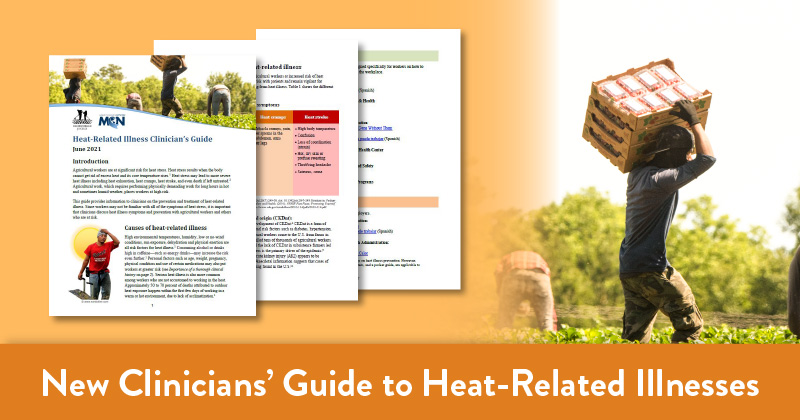Heat, Climate Change, and Outdoor Workers: New Clinicians’ Guide to Heat-Related Illnesses

It’s hot – and it’s getting hotter. Climate change is increasing the number of extreme-heat days across the US. This increase in heat is dangerous for outdoor workers, from agricultural workers, to roofers and construction workers, to airport runway workers. It’s also concerning for certain indoor workers who do not have a climate-controlled environment, like some workers in restaurants, packing houses, and warehouses.
Agricultural workers are particularly vulnerable to overexertion in the heat. Piecework pay (rather than hourly wages) discourages the utilization of break times during which they could rehydrate and rest in the shade. Agricultural workers on large farms may find shade and water break locations far from their working location. Some who apply pesticides may need to wear personal protective equipment which increases the risk of heat stress. Concurrent exposures to wildfire smoke, now a regular occurrence in summers and falls across the West, or to pesticides, may exacerbate underlying health conditions that are already triggered by heat stress, like asthma. Further, many may leave a hot workplace at the end of the day to return to substandard farm housing without climate controls and with insufficient ventilation, reducing their bodies’ ability to recover during the night.
There are currently no federal heat regulations, meaning workers are not legally protected from working in dangerously hot conditions or ensured basic safety precautions are followed. Three states have standards: California, Washington, and Minnesota. California’s standard requires the provision of rest, shade, and water – the three critical aspects to prevent heat-related illnesses and to alleviate mild heat-related illnesses. Around the country, however, many workers are unaware of the health risks of extreme heat, nor the increased risks of heat-related illness as a result of climate change.
This month, Farmworker Justice and Migrant Clinicians Network joined forces to develop a new Clinicians’ Guide to Heat-Related Illnesses. The eight-page guide, available in Spanish and English, covers numerous topics that a clinician serving agricultural workers should consider, from basic recognition and treatment of heat stress, heat exhaustion, heat cramps, and heat stroke, to complications regarding chronic kidney disease of nontraditional origin. It includes a list of medications and individual factors that may increase a worker’s risk of heat-related illness, as well as tips for prevention and post-treatment follow-up. It also includes links to resources for more information geared for clinicians, patients, and employers.
Clinicians are encouraged to use the guide to better acquaint themselves with heat-related illnesses and to set a strategy for how to education agricultural worker patients who may be at risk. The guide is presently available for download; other online-accessible versions of the guide are forthcoming.
Download the Clinicians’ Guide to Heat-Related Illnesses here.
Visit our Heat-Related Illnesses page, which is newly updated with new resources here.
Got some good news to share? Contact us on our social media pages above.
Return to the main blog page or sign up for blog updates here.
- Log in to post comments